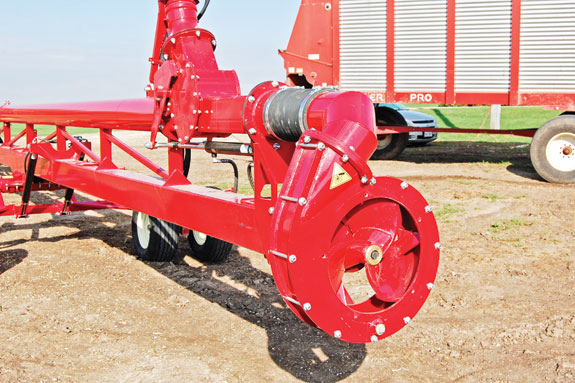Manure management is one of the many concerns dairy producers deal with across the country, especially when part of the nutrient management plan involves collecting and moving manure off of the dairy premises. Whether you are a dairy producer or commercial manure applicator, you probably have encountered some type of problem during this process that links back to the manure pump. Has your pump broken down due to gearbox failures? Ever have a situation where your propeller agitator doesn’t reach far enough into your lagoon or have a lagoon pump that has the reach but cannot cut through thick crust buildup?
Earlier this year, Jamesway Farm Equipment , an agricultural machinery manufacturer based out of Quebec, Canada, launched the PUMPELLER Hybrid Lagoon Pump.
The new pump cuts out gearbox hassles by removing the gearbox altogether and instead implements a patented hybrid turbine to cut through tough solids in a quick and easy manner.

Developing the hybrid
Ralph Fanning, sales manager at Jamesway , explains that although the company launched this product, the idea of a gearbox-less pump came from a custom manure hauler in California who had encountered continuous troubles with gearboxes.
Gearboxes fall under attack from sand, manure acids, twine and plastic wrapping, which are factors that only become worse when the pumps are placed under a heavy load, he says.
The custom hauler ventured out to create a new gearbox-less pump and presented it to Jamesway at World Dairy Expo several years ago.
The hauler’s pump basically used a household water pump with a squirrel-cage exterior. Fanning explains that this pump worked well in California because the manure consistency is more fluid there; however, the pump would quickly clog up if used in situations with thicker manure solids.
“If you’ve never dealt with plugged pumps, you don’t know how big of a deal this is,” he says.
Click here to view a related video, featuring Joe Horkan of Jamesway Farm Equipment.
After some preliminary experimentation with the pump, Jamesway purchased the patent from the custom hauler and headed into a three-and-a-half-year period of research and development to create the hybrid pump.
“Our engineers ended up reversing the flow direction and removing the squirrel-cage housing,” Fanning says. “Mechanically, this design is not the same as the original design, but the principle is still there.”
Once developed, Jamesway sent a series of these pumps to custom haulers and large farms in areas such as Pennsylvania, Vermont and Ontario, Canada, in order to see how well the pump held up to difficult manure solids.
First-hand experience
Scott Forbes, a producer from Lancaster, New Hampshire, had one of the hybrid pump prototypes tested on his farm. With a total herd of 3,000 cows, including 1,000 milking cows, he says he uses lagoon pumps as part of the manure management plan on his farm.
Forbes explains that he had previously used a lagoon pump and a propeller agitator to mix the manure in the pit, which was time-consuming and resulted in higher fuel costs due to having to use more than one tractor. He also mentions running into gearbox problems in the past with previous lagoon pumps.
After using the new hybrid pump on his manure pit, it replaced the agitator he was using and also cut the time spent mixing, he says.
The hybrid pump was able to mix 85 percent of his 180-foot-by-235-foot manure pit in four hours, which was close to half the time spent before using a gearbox pump.
After seeing how well the hybrid pump worked for him during the testing period, Forbes ended up purchasing his prototype. He points out that the only disadvantage he noticed was when the hybrid pump mixed the bottom of the pit. He says the pump still worked, just not as fast.
How the hybrid pump works
Traditional lagoon pumps use cannon power to primarily cut difficult solids and a gearbox-driven propeller to promote the flow of manure through the lagoon pump.
However, the new hybrid pump uses the patented PUMPELLER turbine, which combines a propeller agitator and impeller into one single unit.
The fins on the propeller pressure-feed the flow of manure into the impeller’s blades, creating a higher intake pressure and increasing flow, even in thicker manure solids.
The pump’s turbine-impeller then cuts through the solids and thick crusts at a rate of 50 cuts per second. “By the time it passes through that turbine, the solids are puréed; there’s nothing left,” Fanning says.
The new hybrid pump design produces 44 percent more flow on 17 less horsepower than the equivalent gearbox and propeller models, Fanning explains. The pump is also able to withstand debris, such as twine and plastic that is accidentally fed into the pump.
“Our worst case so far was a fence post,” Fanning says. “We ended up with some chunks of wood stuck in the cannon, so all we did was undo the coupler and dump out the wood and the pump went right back to work.”
Make the pump fit your needs
A year before launching the hybrid pump, Jamesway introduced changes to its entire lagoon pump family to prepare for the release of the new hybrid pump, Fanning says.
One of these changes was to implement a 250-horsepower heavy-duty driveline to help support a trouble-free operation. An oilbath bearing assembly was also added to the heavy-duty final drive shaft on the hybrid pump to make the pump resistant to sand, twine and plastic.
The hybrid turbine itself is available as a 540-rpm model (115 horsepower) or the 1,000-rpm model (180 horsepower). The customer can also choose among other accessories such as transport or wheel kits.
The price of a new hybrid lagoon pump falls within the $25,000 range but will depend on the pump setup chosen. The customer can choose between a trailer model and a three-point hitch model.
Both of the model types have different lengths to select from as well. “The equipment is priced between a standard lagoon pump and a gearbox lagoon pump,” Fanning says.
The end results of using the hybrid pump include cost savings in servicing or repairing the pumps because the gearbox problems are eliminated from the cost equation.
Customers may also experience an increase in fuel savings because the new hybrid can do multiple tasks with one product.
“The extreme simplicity and the extreme versatility through the widest ranges of manures we encounter have been the key factors to us,” Fanning says. “The ability to do the job faster with less fuel and less horsepower all with having no gearbox is very attractive to people.” PD
If you are interested in learning more about the hybrid lagoon pump, contact Ralph Fanning at (819) 845-7824.
YOUR RESULTS
Would you benefit from this type of lagoon pump? The following checklist can be used to determine if this new technology might be a fit for your operation.
- Are you a custom hauler or do you operate a large dairy?
- Are you interested in a more efficient way of handling manure?
- Does your lagoon have a thick crust?
- Do you carefully consider your manure pump options?
- Are you interested in saving time mixing your manure pit?
- Have you ever had trouble with gearboxes before?
If you answered yes to four or more of these questions, this technology may be one for you to consider.
PHOTO
The idea for Jamesway’s new hybrid lagoon pump was born several years ago at World Dairy Expo. A custom manure hauler provided the concept for this new innovation. Photo courtesy of Jamesway Farm Equipment.



.jpg?t=1687979285&width=640)



